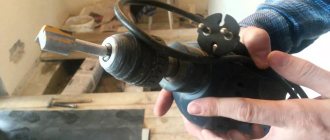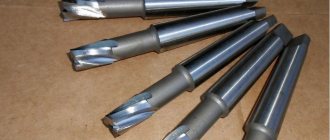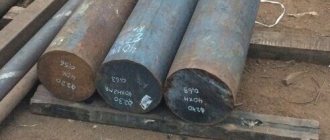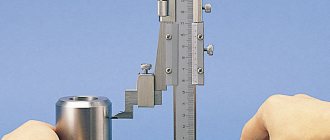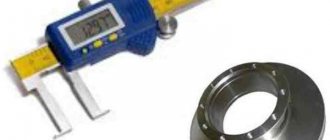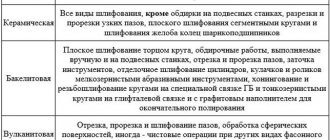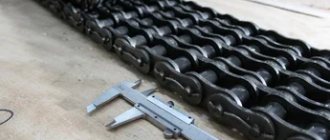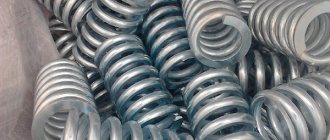2 Normative references
This standard uses normative references to the following standards:
GOST R 52965-2008 Cylindrical shanks for milling cutters. Main Dimensions
GOST 8.051-81 State system for ensuring the uniformity of measurements. Errors allowed when measuring linear dimensions up to 500 mm
GOST 1050-88 Long rolled products, calibrated with special surface finishing from high-quality carbon structural steel. General technical conditions
GOST 1412-85 Cast iron with flake graphite for castings. Stamps
GOST 1574-91 Machined T-shaped grooves. Dimensions
GOST 2789-73 Surface roughness. Parameters and characteristics
GOST 2848-75 Tool cones. Tolerances. Methods and controls
GOST 4543-71 Rolled alloy structural steel. Specifications
GOST 9013-59 Metals. Rockwell hardness testing methods
GOST 9378-93 Surface roughness samples (comparison). General technical conditions
GOST 18088-83 Metal-cutting, diamond, wood-cutting, plumbing and auxiliary tools. Packaging, labeling, transportation and storage
GOST 19265-73 High-speed steel rods and strips. Specifications
GOST 23726-79 Metal-cutting and wood-cutting tools. Acceptance
GOST 25706-83 Magnifiers. Types, basic parameters. General technical requirements
Note
-
When using this standard, it is advisable to check the validity of the reference standards in the public information system
-
on the official website of the Federal Agency for Technical Regulation and Metrology on the Internet or according to the annually published information index “National Standards”, which was published as of January 1 of the current year, and according to the corresponding monthly information indexes published in the current year. If the reference standard is replaced (changed), then when using this standard you should be guided by the replacing (changed) standard. If the reference standard is canceled without replacement, then the provision in which a reference is made to it is applied in the part that does not affect this reference.
DESIGN ELEMENTS AND GEOMETRICAL PARAMETERS OF MILLS
1. Structural elements and geometric parameters of cutters are indicated in Fig. 1, 2 and in table. 12.
2. It is allowed to make a recess on the Morse taper for marking.
Crap. 1
Crap. 2
Table 1
Dimensions in mm
| d | l | l 1 | d 1 | d 2 | z | h | h 1 | r | r 1 | f | f 1 | f 2 | Morse cone |
| 10 | 22 | 1,8 | 9,5 | 5,0 | 4 | 2,4 | 2,3 | 1,0 | 1,0 | 1,5 | 1,0 | 1,2 | 1 |
| 11 | 10,5 | 2,5 | 1,2 | ||||||||||
| 12 | 26 | 11,5 | 5,5 | 3,0 | 2,5 | 2,0 | 1,5 | ||||||
| 2 | |||||||||||||
| 14 | 11,5 | 6,5 | 1 | ||||||||||
| 13,5 | 2 | ||||||||||||
| 16 | 32 | 15,5 | |||||||||||
| 18 | 2,3 | 17,5 | 7,0 | 3,5 | 3,5 | 2,0 | |||||||
| 20 | 38 | 2,5 | 17,5 | 9,0 | 5 | 3,6 | 1,5 | ||||||
| 19,5 | 3 | ||||||||||||
| 22 | 17,5 | 10,0 | 3,9 | 4,0 | 2,2 | 2 | |||||||
| 21,5 | 3 | ||||||||||||
| 25 | 45 | 4,0 | 23,5 | 4,5 | 4,5 | 2,5 | |||||||
| 28 | 5,5 | 23,5 | 12,0 | 5,0 | 3,0 | 2,0 | 2,0 | 1,5 | |||||
| 26,0 | 4 | ||||||||||||
| 32 | 53 | 5,5 | 23,5 | 12,0 | 6 | 3 | |||||||
| 30,0 | 4 | ||||||||||||
| 36 | 6,0 | 23,5 | 15,0 | 5,5 | 5,0 | 3,5 | 3 | ||||||
| 30,0 | 4 | ||||||||||||
| 40 | 63 | 7,5 | 30,0 | 17,0 | 6,0 | 4,0 | 1,8 | ||||||
| 39,5 | 5 | ||||||||||||
| 45 | 8,0 | 30,0 | 19,0 | 7,0 | 6,0 | 2,5 | 4 | ||||||
| 42,0 | 5 | ||||||||||||
| 50 | 75 | 9,0 | 30,0 | 23,0 | 7,5 | 7,0 | 5,0 | 4 | |||||
| 42,0 | 5 | ||||||||||||
| 56 | 9,5 | 30,0 | 26,0 | 8 | 8,0 | 7,5 | 6,0 | 3,0 | 3,0 | 2,8 | 4 | ||
| 42,0 | 5 | ||||||||||||
| 63 | 90 | 10,0 | 42,0 | 29,0 | 9,0 | 8,0 |
table 2
Dimensions in mm
| d | l | l 1 | d 1 | d 2 | z | h | h 1 | r | r 1 | f | f 1 | f 2 | Morse cone |
| 10 | 22 | 1,8 | 9,5 | 6,5 | 3 | 2,7 | 2,3 | 1,3 | 1,0 | 1,5 | 1,0 | 1,2 | 1 |
| 11 | 10,5 | 2,8 | 2,4 | 1,4 | |||||||||
| 12 | 26 | 11,5 | 3,0 | 2,5 | 2,0 | 2 | |||||||
| 2 | |||||||||||||
| 14 | 11,5 | 1 | |||||||||||
| 13,5 | 2 | ||||||||||||
| 16 | 32 | 15,5 | 3,5 | 3,0 | |||||||||
| 18 | 2,3 | 17,5 | 7,0 | 4,0 | 3,5 | ||||||||
| 20 | 38 | 2,5 | 17,5 | 9,0 | 4,8 | 4,0 | 2,4 | 1,5 | |||||
| 19,5 | 3 | ||||||||||||
| 22 | 17,5 | 10,0 | 5,1 | 2,6 | 2 | ||||||||
| 21,5 | 3 | ||||||||||||
| 25 | 45 | 4,0 | 23,5 | 6,0 | 4,5 | 3,0 | |||||||
| 28 | 5,5 | 23,5 | 12,0 | 7,0 | 5,0 | 4,0 | 3 | 2,0 | 1,5 | ||||
| 26,0 | 4 | ||||||||||||
| 32 | 53 | 23,5 | 4 | 8,0 | 6,5 | 2,0 | 3 | ||||||
| 30,0 | 4 | ||||||||||||
| 36 | 6,0 | 23,5 | 15,0 | 7,0 | 3 | ||||||||
| 30,0 | 4 | ||||||||||||
| 40 | 63 | 7,5 | 30,0 | 17,0 | 9,0 | 8,0 | 5,0 | 1,8 | |||||
| 39,5 | 5 | ||||||||||||
| 45 | 8,0 | 30,0 | 19,0 | 9,5 | 9,0 | 2,5 | 4 | ||||||
| 42,0 | 5 | ||||||||||||
| 50 | 75 | 9,0 | 30,0 | 23,0 | 10,0 | 10,0 | 4 | ||||||
| 42,0 | 5 | ||||||||||||
| 56 | 9,5 | 30,0 | 26,0 | 5 | 12,0 | 3,0 | 2,8 | 4 | |||||
| 42,0 | 5 | ||||||||||||
| 63 | 90 | 10,0 | 42,0 | 29,0 | 14,0 |
APPENDIX 1. (Changed edition, Amendment No. 4).
Related Posts via Categories
A hob cutter as a reliable tool for spline shafts A cutting disc cutter is a very durable and wear-resistant tool A finger cutter is a fancy name for an important object A round conical cutter is the difficult life of one tool Cutting modes during milling - how to perform an analytical calculation? Milling cutter with a cylindrical shank - GOST requirements for tools Milling cutters for face milling - features of a multi-edge tool Milling grooves - how to perform the operation efficiently? Turning and milling machining centers - highly efficient universal machines FSSH-1A - a machine for high-quality milling of wooden workpieces
Special types
In addition to cylindrical end mills, a large range of milling tools is produced, which belong to the same group, but have different shapes and composition of cutting surfaces. This also includes small-sized end mills, which are usually mounted, but with small diameters they are made of all-metal and are classified as end mills.
The most common types are:
- Keyed. They have two cutting surfaces at the end, which allows cutting in both longitudinal and perpendicular directions. Used for milling keyways on shafts and longitudinal grooves on flat workpieces.
- Angular. Their characteristic feature is inclined cutting edges at the end. Designed for removing rectangular edges (chamfers), processing inclined planes and corner grooves.
- Quarter round concave. Their cutting teeth are shaped like a reverse arc. Used for milling rounded edges.
- For T-shaped and dovetail slots. The cutting part is disk-shaped and has a larger diameter than the shank. Used for milling long slots of the appropriate configuration.
- Copiers with a cylindrical or conical working surface and a rounded end. They are used in the manufacture of stamping tools, molds and various models.
In addition, there are many types of shaped end mills that are capable of forming multi-stage rectangular and round profiles in one pass. This type of milling tool is mainly used in carpentry and plastic processing.
INFORMATION DATA
1. DEVELOPED AND INTRODUCED by the Ministry of Machine Tool and Tool Industry of the USSR
DEVELOPERS
DI. Semenchenko, Ph.D. tech. Sci. N.I. Minaeva; T.A. Lavrenova
2. APPROVED AND ENTERED INTO EFFECT by Resolution of the State Committee of Standards of the Council of Ministers of the USSR dated 06/09/71 No. 1104
3. Inspection period - 2000, inspection frequency - 10 years
4. The standard fully complies with ST SEV 109-79
5. INSTEAD GOST 8237-57 regarding milling cutters with a cylindrical shank, MN 409-65, MN 410-65
6. REFERENCE REGULATIVE AND TECHNICAL DOCUMENTS
| Designation of the referenced technical document | Item number |
| GOST 25334-94 | |
| ISO 1641-1-78 | 2, 12 |
7. The validity period was removed by Decree of the State Standard of March 25, 1982 No. 1232
8. REISSUE (March 1998) with Amendments No. 1, 2, 3, 4, 5, 6, approved in February 1973, January 1977, March 1982, April 1985, March 1991. , September 1995 (IUS 2-73, 2-77, 6-82, 7-85, 6-91, 12-95)
Preface
The goals, basic principles and general rules for carrying out work on interstate standardization are established by GOST 1.0 “Interstate standardization system. Basic provisions" and GOST 1.2 "Interstate standardization system. Interstate standards, rules and recommendations for interstate standardization. Rules for the development, adoption, updating and oVNIIINSTRUMENT" (JSC "VNIIINSTRUMENT") based on its own translation into Russian of the English version of the standards specified in paragraph 5
2 INTRODUCED by the Interstate Technical Committee for Standardization MTK 95 “Tool”
3 ADOPTED by the Interstate Council for Standardization, Metrology and Certification (protocol dated June 25, 2014 N 45)
The following voted for adoption:
| Short name of the country according to MK (ISO 3166) 004-97 | Country code according to MK (ISO 3166) 004-97 | Abbreviated name of the national standardization body |
| Azerbaijan | AZ | Azstandard |
| Armenia | A.M. | Ministry of Economy of the Republic of Armenia |
| Belarus | BY | State Standard of the Republic of Belarus |
| Kazakhstan | KZ | Gosstandart of the Republic of Kazakhstan |
| Kyrgyzstan | KG | Kyrgyzstandard |
| Moldova | M.D. | Moldova-Standard |
| Russia | RU | Rosstandart |
| Tajikistan | T.J. | Tajikstandard |
| Turkmenistan | TM | Main State Service "Turkmenstandartlary" |
| Uzbekistan | UZ | Uzstandard |
| Ukraine | U.A. | Ministry of Economic Development of Ukraine |
4 By Order of the Federal Agency for Technical Regulation and Metrology dated June 3, 2015 N 530-st, the interstate standard GOST 32831-2014 (ISO 1641-1:2003, ISO 1641-2:2011, ISO 1641-3:2011) was put into effect as a national standard of the Russian Federation from January 1, 2016.
5 This standard is modified from the following international standards regarding end mills: ISO 1641-1:2003* “End and keyed cutters. Part 1. Milling cutters with cylindrical shanks" ("End mills and slot drills - Part 1: Milling cutters with cylindrical shanks", MOD); ISO 1641-2:2011 “End and key cutters. Part 2. Dimensions and designation of milling cutters with Morse taper shanks” (“End mills and slot drills - Part 2: Dimensions and designation of milling cutters with Morse taper shanks”, MOD); ISO 1641-3:2011″End and key cutters. Part 3. Dimensions and designation of milling cutters with 7/24 taper shanks (MOD) by adding additional provisions.
________________
* Access to international and foreign documents mentioned in the text can be obtained by contacting the User Support Service. — Note from the database manufacturer.
International standards are developed by Technical Committee for Standardization ISO/TC 29 Tools, Subcommittee SC 2 High-speed cutting steel tools and accessories of the International Organization for Standardization (ISO).
Additional provisions are given in paragraphs 3.1, 3.11-3.20, Appendix A and are enclosed in thin lines or in bold italics*. Additional requirements have been introduced for the possibility of manufacturing milling cutters at enterprises.
________________
* In the original, the designations and numbers of standards and regulatory documents in section 3 “Types and main sizes” are in italics, except for those given in the frame, the rest of the document text is given in normal font. — Note from the database manufacturer.
References to international standards that have been adopted as interstate standards have been replaced in the “Normative References” section and the text of the standard with references to the corresponding modified interstate standards.
References to international standards that are not accepted as interstate standards are retained or replaced in the section “Normative references” and the text of the standard with references to the corresponding interstate standards.
The name of this standard has been changed relative to the name of the international standard to bring it into compliance with GOST 1.5 (subsection 3.6).
A list of technical deviations with explanations of the reasons for their introduction is given in Appendix DA.
6 This standard has been prepared based on the application of GOST R 53002-2008
________________
By order of the Federal Agency for Technical Regulation and Metrology dated June 3, 2015 N 530-st, the GOST R 53002-2008 standard was canceled as of January 1, 2016.
7 INTRODUCED FOR THE FIRST TIME
8 REPUBLICATION. May 2022
Information on the entry into force (termination) of this standard and amendments to it on the territory of the above states is published in the indexes of national standards published in these states, as well as on the Internet on the websites of the relevant national standardization bodies.
In case of revision, modification or cancellation of this standard, the relevant information will be published on the official website of the Interstate Council for Standardization, Metrology and Certification in the catalog “Interstate Standards”
Classification of end mills
There is no special extended classification for end millers, therefore they are classified according to lists common to milling tools with the addition of their characteristic features. Below are the main sections of the classification used for various types of metal end mills:
By production purpose
In this section, the main feature is the type and shape of the surface being processed. Based on this, the following types of this tool are distinguished:
- general use;
- with end cutting part;
- for keyways (including for slots of segmental keys);
- for figured grooves;
- for shaped flat profiles;
- carbon copies.
By design
GOST obliges manufacturers to produce end mills of two types of lengths: normal and long and determines the ratio of the dimensions of the shank and the cutting part. But in addition to this, there are end mills on the market, both elongated and very short (popularly called “finger”). In addition to the types and length ratios, GOST defines the types of shanks (various types of conical and cylindrical), as well as size ranges of diameters. Most often in industrial production, an end mill with a conical shank is used.
State standards define only general requirements for milling tools. At the same time, global manufacturers offer various innovative designs. An example of these are modular end mills, in which the cutting part is attached to the shank using a high-precision screw connection. Another interesting development is a six-flute overrunning end mill with top and bottom bearings for finishing slots using a template.
According to the shape of the cutting surfaces
To form specific surface profiles of workpieces, in addition to general-purpose tools, a large group of shaped end mills was created. Among them, the main ones are radius and shaped groove milling tools, as well as milling cutters for 2D and 3D processing. The main types of end milling machines, classified according to the shape of the cutting surfaces, are:
- cylindrical;
- end;
- keyed;
- radius end mill;
- radius concave cutter;
- T-shaped cutter;
- cutter for dovetail groove;
- corner end mill;
- Conical and cylindrical end mills with straight and rounded ends.
By the number of cutting edges and direction of rotation
The process of burying a cutting edge into the metal and removing one layer of allowance with it is called “setting in.” The more cutting surfaces a router has, the more passes it makes per revolution. An end milling tool with one cutting surface is single-cut. If there is more than one surface, then the tool is multi-start (single-, double-start cutters, etc.).
In addition, there is an extensive classification of end mills based on the geometry and shape of the cutting surfaces, teeth and edges.
Related Posts via Categories
End mills with a conical shank - fast and convenient milling Hob cutter as a reliable tool for spline shafts Parting disc cutter - a very durable and wear-resistant tool Finger cutter - a fancy name for an important object Round conical cutter - the difficult life of one tool Cutting modes for milling - how to perform analytical calculation? Face milling cutters - features of a multi-edge tool Milling grooves - how to perform the operation efficiently? Turning and milling machining centers - highly efficient universal machines FSSH-1A - a machine for high-quality milling of wooden workpieces
INFORMATION DATA
GOST 26877-2008.
metal products. methods for measuring shape deviations 1. DEVELOPED AND INTRODUCED by the Ministry of Machine Tool and Tool Industry of the USSR
DEVELOPERS
DI. Semenchenko, Ph.D. tech. sciences; N.I. Minaeva; T.A. Lavrenova
2. APPROVED AND ENTERED INTO EFFECT by Resolution of the State Committee of Standards of the Council of Ministers of the USSR dated 06/09/71 No. 1105
3. Inspection period - 2000, inspection frequency - 10 years
4. The standard fully complies with ST SEV 109-79
5. INSTEAD OF GOST 8237 regarding cutters with a conical shank, MN 411-65, MN 412-65
6. REFERENCE REGULATIVE AND TECHNICAL DOCUMENTS
| Designation of the referenced technical document | Item number |
| GOST 14034-74 | 1.7 |
| GOST 17024-82 | 1.10 |
| GOST 25334-94 | 1.6 |
| ISO 1641-2-78 | 1.2, 1.11 |
7. The validity period was removed by Decree of the State Standard of March 25, 1982 No. 1232
8. REISSUE (March 1998) with Amendments No. 1, 2, 3, 4, 5, approved in February 1973, January 1977, March 1982, April 1985, September 1995 (IUS 2-73, 2-77, 6-82, 7-85, 12-95)
GOST 17026-71 End mills with a conical shank. Design and dimensions
